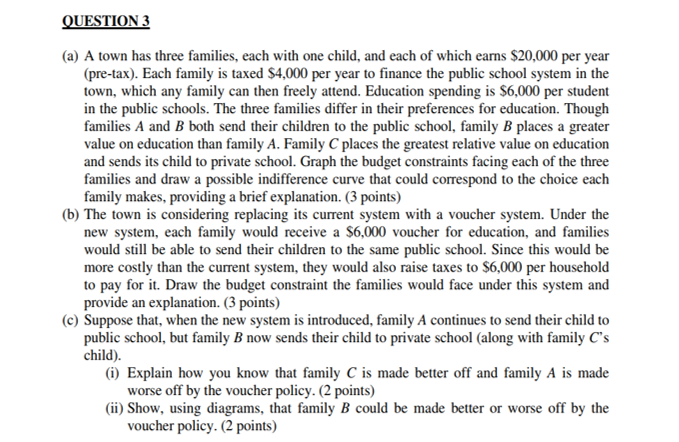Question
QUESTION 3 (a) A town has three families, each with one child, and each of which earns $20,000 per year (pre-tax). Each family is taxed
QUESTION 3
(a) A town has three families, each with one child, and each of which earns $20,000 per year
(pre-tax). Each family is taxed $4,000 per year to finance the public school system in the
town, which any family can then freely attend. Education spending is $6,000 per student
in the public schools. The three families differ in their preferences for education. Though
families A and B both send their children to the public school, family B places a greater
value on education than family A. Family C places the greatest relative value on education
and sends its child to private school. Graph the budget constraints facing each of the three
families and draw a possible indifference curve that could correspond to the choice each
family makes, providing a brief explanation. (3 points)
(b) The town is considering replacing its current system with a voucher system. Under the
new system, each family would receive a $6,000 voucher for education, and families
would still be able to send their children to the same public school. Since this would be
more costly than the current system, they would also raise taxes to $6,000 per household
to pay for it. Draw the budget constraint the families would face under this system and
provide an explanation. (3 points)
(c) Suppose that, when the new system is introduced, family A continues to send their child to
public school, but family B now sends their child to private school (along with family C's
child).
(i) Explain how you know that family C is made better off and family A is made
worse off by the voucher policy. (2 points)
(ii) Show, using diagrams, that family B could be made better or worse off by the
voucher policy. (2 points)

Step by Step Solution
There are 3 Steps involved in it
Step: 1

Get Instant Access to Expert-Tailored Solutions
See step-by-step solutions with expert insights and AI powered tools for academic success
Step: 2

Step: 3

Ace Your Homework with AI
Get the answers you need in no time with our AI-driven, step-by-step assistance
Get Started


